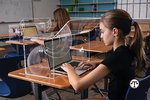

(NAPSI)—A new approach to indoor ventilation has been developed that can significantly decrease the risk of COVID and influenza outbreaks in schools, offices and other indoor environments, and even speed a reduction in mask wear.
The innovative invention captures and cleans individuals’ breaths within seconds, before potential viruses have a chance to be dispersed throughout a room, improving overall indoor air quality. Current methods, including upgrades to existing HVAC systems, have proven somewhat ineffective as COVID outbreaks continue to create disruptions in indoor settings throughout the United States.
“Existing ventilation systems in schools, offices and elsewhere were not built for virus control. Not only does better ventilation decrease the risk of catching COVID, it has been shown to also improve work productivity and school performance,” said Larry Schoen, P.E., Fellow ASHRAE, Principal Engineer for Schoen Engineering Inc. “And even after upgrading a traditional HVAC ventilation system with better filters, it still allows virus-laden air to affect others in a room, creating the potential for contagion.”
According to Dr. Rama Rao Amara, Emory University School of Medicine: “We know that COVID, as well as many other viruses, are airborne, meaning they spread through the air in microscopic, aerosolized particles. So, it makes sense that these particles can be easily pulled by the room’s HVAC system or larger air purifier. To stop COVID and other pathogens, such as influenza or even the common cold from spreading in indoor environments, it is vital to capture an exhaled breath before these aerosols have a chance to journey around a room. We need to re-evaluate how indoor air quality is managed.”
Called Air-Clenz, the new technology has been customized for classrooms so teachers can see students as they did in pre-COVID settings. The size and positioning of the unit on the desk or cafeteria tabletop let students place their computers, textbooks or lunch trays within the air collection unit, so exhaled air is captured and cleaned of viruses or other pathogens while a student studies, eats or works.
“Capturing exhaled air close to the face before it becomes dispersed has been totally overlooked,” said Stuart Sheldon, CEO of Air-Clenz Systems. “Except for a face mask, which most individuals would not want to wear for the rest of their lives, there is no known system in the world that captures even 50 percent of one’s exhaled air without also cleaning 100 percent of the air in a room or enclosed space. There are literally hundreds of different commercial air purifiers and HVAC system options, but none come close to achieving what Air-Clenz can achieve.”
The technology adds to the HVAC system for even cleaner air.
Dr. Anita Broach, Air-Clenz’s Chief Scientist, adds: “Research demonstrates that Air-Clenz’ technology typically captures and cleans more than an estimated 85 percent of a person’s exhaled breath in approximately three seconds. The captured air is then cleaned to a 99.9 percent level before being recirculated.
Learn More
For further facts, visit www.air-clenz.com.
